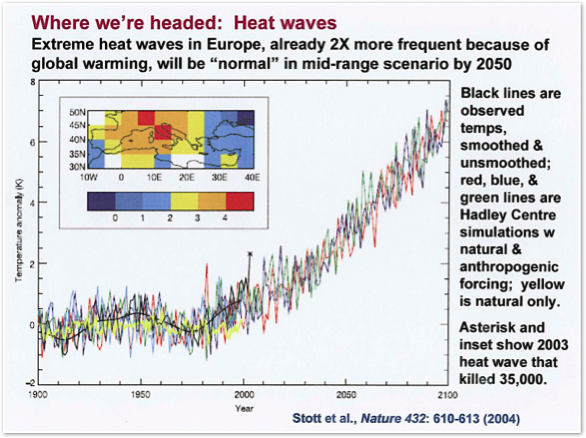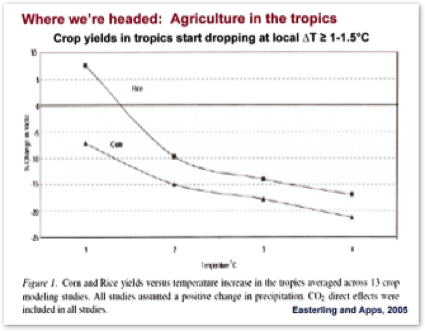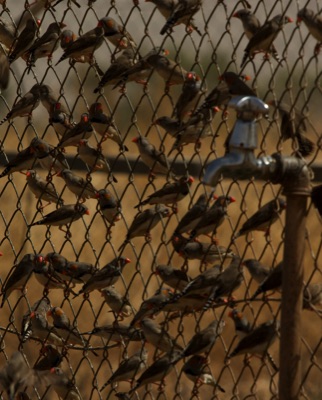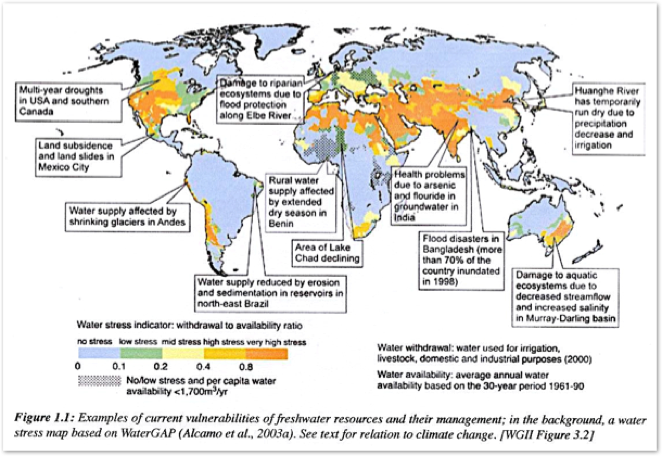
Consequences ... many reasons to change course
This is a sketch of some of the foreseeable effects of warming. Some of them are more predictable than sea-level rise; some less. They tend to focus on the human world (for obvious reasons) ... but all our fellow creatures will be affected too, to varying degrees.
Other species
The problem of climate change for all species (including us) is how fast it’s happening. When the post-glacial warming began about 16,000 years ago, its average rate for the next five millennia was 0.01℃ per decade. Right now it is about 15 times as fast; in the coming century it is expected to speed up again to perhaps as much as 0.4℃ every decade. At this rate, temperature zones will be moving toward the poles at about 120 km a decade - way too fast for most plants to keep up. If the plants don’t make it, animals that depend on them won’t either. Whole ecosystems will be eliminated - in fact the process can be seen already. When climatic zones move, their weather goes with them. That means patterns of rain and snowfall will shift polewards. While the equatorial tropics will be very wet and very hot, an enlarged subtropical zone will be very dry as well as hot - including all of mediterranean Europe, Southern Africa, Australia, central South America, Central Asia and the western US. These are vast destructive changes. Alarms over threatened species will be so common they won’t bother us; we’ll have other things to worry about.
Many attempts have been made to assess how much extinction will follow various climate change scenarios. These are notoriously difficult predictions, but it seems clear that under plausible future states, something like a third to a half of species could vanish, depending very much on regional factors. Creatures that cannot migrate (those that are confined to islands or mountains), those that lose irreplaceable resources, and plants that can’t disperse rapidly enough will be most vulnerable.
Here's a good recent review of our state of knowledge about species extinction risk
Food production
A lot of modelling work has been done to figure out how agricultural systems will respond to future warming. As you’d expect, the studies give somewhat different results for different countries, but a global estimate for tropical crops - rice and corn - finds that after an initial increase of yield, as temperatures rise from 1℃ to 2℃, rice yield falls by 10%; corn by 15%. With further heating, yields continue to decline. For temperate crops, the yield losses are smaller, but highly significant. These calculations reflect the intolerance of agricultural staples to higher temperatures (they do include the so-called CO2 fertiliser effect) - but they don’t allow for crop losses due to proliferation of pests, new diseases, or severe weather and flooding. Nor do they show that large productive areas in most countries won’t be suitable in the future (this is already happening in Africa with ghastly consequences).
Forests
All of the world’s forests have been devastated, especially in the last 50 years. As developed countries began conservative management of their own estates, the great tropical forests were relentlessly exploited. The chart here shows the effect this mismanagement has had on net CO2 flux to the atmosphere.
Right now, something like 100,000 Ha of tropical forest is destroyed every day. Most harvesting is wasteful, and most land use conversion doesn’t last long; grassland burns, soils desiccate - so what was once a carbon sink becomes a source.
The world’s greatest forest appears to be dying - from two anthropogenic causes. The original ecosystem was so vast that it made its own climate, and affected the rest of the globe. Now it is becoming steadily drier - no longer able to govern precipitation over the basin. Big areas are opened by felling and burning and desiccation. The best estimates suggest it will not survive another century. As the forest turns into savanna and desert, huge quantities of greenhouse gases will enter the atmosphere, and a vast economic and biological resource will be lost forever.
There is a recent review of this question here
Heat waves
Heat kills. In 2003, in the worst heat wave on record to that time in Europe, an estimated 35,000 people died. The average temperature across the continent was 2.3℃ higher than normal. The Hadley Centre’s model for future European climate predicts that in 30 years, assuming a bit less than 2℃ global rise, half of the summers will be as hot as 2003; the bad ones much worse. Heat waves won’t be distributed evenly around the world.
The graph here is from a study by Peter Stott, who found:
• The probability of such a heat wave had been doubled by global warming;
• In 2050, a summer as hot as 2003 could be expected every second year;
• By 2075, such a summer would be anomalously cool (assuming an emissions trajectory in the IPCC mid-range).
The Russian heat wave of 2010
From June to August 2010, much of the land area of the northern hemisphere suffered periods of severe heat. The summer culminated in an extremely unusual heat wave centred in Russia and north-eastern Europe from late June until early August which inflicted enormous damage and major loss of life and property.
Superimposed on a prolonged drought, the worst wildfires on record devastated a large area mainly in western Russia. There were severe crop losses, and an estimated 56,000 casualties from causes related to the heat - heat-stress, smoke inhalation, incineration.
In summer 2012, Russia suffered an even worse season of wildfires, again with great economic and human loss.
A study of the 2010 event showed that, on the basis of climate records, its likelihood was so small, it may well have been unique. The authors also observed that the probability of mega-heat waves like 2003 & 2010 would be 5-10 times greater in the next 40 years.
The graph shows a frequency distribution for European summer maxima, going back 500 years.
The salient thing is how the likelihood of a really hot summer has shifted. After a somewhat warm stretch 200 years ago, the frequency of unusually hot summers rose steeply in this century. All the hottest five summers are 21st century ones. Whereas the coolest five span a period of 400 years, and are clustered near the 5th percentile, the hottest five are all well outside the 95th percentile, and cover a mere 8 years.
Severe weather
Storms are created by heat. The more heat (especially hot ocean surface water) the bigger and stronger they get. This trend has already begun, as the graph from a study by Kerry Emanuel shows. As expected, it’s the energy (size & wind velocity) that responds to ocean warming; the frequency of tropical storms hasn’t changed much.
Floods
Along with storms, a hotter atmosphere and ocean causes a lot more water to evaporate - and to therefore to precipitate. In other words, the "hydrological cycle" is intensified. Right now, the atmosphere holds about 5% more water than it did before the onset of warming ... about 7,000 km3 of it. The net effect is that there are more intense downpours both in the tropics, where they are customary, and in higher latitudes, where they are not.
Insurance data confirms that flood frequency and severity has been increasing for the last 30 years.
This will have consequences for soil erosion, agricultural production, water strorage, river flows, ground-water replenishment, the condition of deltas, fresh-water fisheries, and a lot more.
The graph on the left shows the trend in average storm intensity. The one below, shows major flood events becoming more common
Developing Countries
Developing countries in Central and South America, Asia and Africa will suffer the greatest consequences of climate change. Already prone to very high temperatures, drought and - in some places - famine developing countries lack the resources to deal with widespread increases in temperature. As it stands, in order for developing countries to realize a standard of living approaching that enjoyed in the Western world, they will need to increase industrial production, Countries such as China are doing this with great success; however, in doing so they are greatly contributing to a rise in harmful carbon emissions. It seems that allowing developing countries the resources to fuel their economy may also contribute to their demise.
Many of these countries will be unable to fund initiatives to deal with climatic disaster, should it occur, others (such as China) officially acknowledge the seriousness of climate change, but rapidly expand fossil fuel use just the same. (Nearly all the growth in fossil fuel emissions comes from the big developing nations).There is a clash of concerns here, as the ability of a financially poor country such as Bangladesh (to use one of many examples) will depend upon its ability to develop its economy along the lines that industrial nations already have. Doing this will inevitably lead to an increase in their fuel emissions. This is a cause for great concern, and it is in the interest of Europe and the rest of the developed world to consider initiatives to promote sustainable industry, agriculture and water development throughout Asia, Africa and South America. Global environmental well-being, and the stability of the world in general, will depend on this.
Infectious diseases
The pattern of infectious disease occurrence is closely related to the environmental conditions affecting micro-organisms and vectors - temperature, humidity/aridity, density of host populations, vegetation, presence of standing water, and many other things. Two big concerns preoccupy experts in this field: expansion of the geographical range and virulence of known pathogens, and the emergence of new ones. Obviously, many of these threats are more acute for citizens of poorer nations, but the problem is by no means confined to them.
A summary of some expected changes in distribution and effect of some diseases due to microbes & parasites. The list is not exhaustive. Much research needs to be done to make this climate change consequence more predictable - but there are certain to be surprises if unprecedented climate conditions arrive.
Courtesy WHO:
Water shortages
Paradoxically, while equatorial and high-temperate zones will be wetter, large parts of the world will be short of water. Even in some cooler places, urban and horticultural water supplies will decline because of the loss of mountain snow pack and glacial ice - a problem already recognized by authorities in California and the cities of Lima and Quito, just to name a few. The IPCC Fourth Report estimates the global area subject to water stress will double by 2050. Loss of surface run-off in streams will be made worse by salinization and reduced water quality from other causes.
Global water-stress map
Note that all currently stressed areas are expected to be worse; and large sub-tropical regions not presently afflicted will become stressed.
[Climate Change and Water: IPCC technical paper VI; 2008]
Australia is specially vulnerable because a lot of its productive land is marginal or subject to irregular climate patterns, and because all of its large population centres are already water-stressed.
These maps by CSIRO show projected rainfall change to 2030 & 2070 (on the right); and (above) the net effect of rainfall and evaporation over the continent. Because evaporation increases very dramatically as things warm up, the net effect is a severe loss of available water - the ‘water balance’ is reduced between 40 & 120 mm for every degree of global warming, according to these scientists.
This means much more trouble finding water for Australian cities and farms.
The oceans
In the last 10 years, it’s become clear that the capacity of the oceans to swallow anthropogenic CO2 is limited - in fact a limit has already been reached. The long Antarctic ice cores can be used to show that ocean pH (measure of acidity) was steady at 8.2 throughout the last 600,000 years despite seven glacial cycles of freezing and warming - but in the era of fossil fuel combustion, the last 150, acidity has increased 30%. The reason for the ocean’s intolerance this time is again the speed of the carbon atmospheric flux. In past episodes of rising atmospheric CO2, ocean chemical processes provided a chemical buffering, limiting the concentration of hydrogen ions which cause acidity.
Use this link for more detail
Ocean acidity is a huge problem - in the view of some, maybe the most serious environmental problem caused by the disturbance of greenhouse gases. It means that all marine creatures that depend on calcareous shells or skeletons will have trouble forming these structures - in other words all of the oceanic food-chains will be affected. Coral reefs are special ecosystems adapted to warm waters. Their presence in these otherwise nutrient-poor shallow seas provides rainforest-like biodiversity to the tropical ocean - a quarter of all the inhabitants of the ocean spend at least part of their life-cycle on a reef. But reefs have been depleted by over-exploitation during the past century and now face something that may be terminal - acidification and over-heating. Both are lethal to coral polyps, and both are already affecting reefs all over the tropics. The world’s reefs grew in their present locations sometime after sea-levels stabilized at the end of the last ice age.
Christopher Langdon, an oceanographer speaks for most of his colleagues: “Today’s reefs are as much as 5000 years old, and they will start to fall apart within a decade or so if we don’t radically change how we do business”.
Human conflict
This awful consequence would be just about imponderable were it not that history provides clear guides for our contemplation. Disruption to ecosystems and livelihoods has happened many times before and we know that human societies respond in predictable ways. No people with means at their disposal will succumb to hunger, thirst or the loss of strategic resources or security without attempting redress. We know that these circumstances are inimical to liberty - threatened people resort to primitive expressions of power. If societies of power will be inclined to use it, what of those already deprived? Again, study of the past shows that duress causes the powerless to choose the only remedy they have - to move.
So under foreseeable future conditions, we are bound to witness or participate in coercion, violence, mass migrations and their aftermath, great famines, desolation and disease - all in a state of affairs in which illiberal governance will flourish at the expense of our accustomed freedom. This is the world we may promise our grandchildren. It is no fancy, and it is not the product of some imagined cultural or political bias - it is the fruit of the labour and the most sober reflection by the best informed minds we have. In the predicament we face - incomplete knowledge but very dire prognosis - we really have no choice but to act on what we know and what we can infer. What could possibly justify or warrant doing otherwise?
I wish to acknowledge the use of charts and figures from John Holdren’s lecture at the John F Kennedy School of Government, Harvard, November 2007. The lecture can be found at:
http://belfercenter.ksg.harvard.edu/publication/17661/global_climate_disruption.html
John is a distinguished scientist and advocate who has also served as the President's chief science advisor since 2008

*















There's a review of global flood trends here



